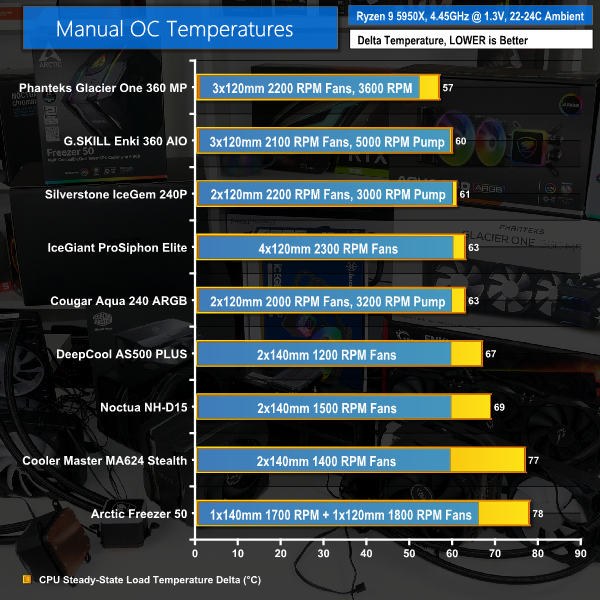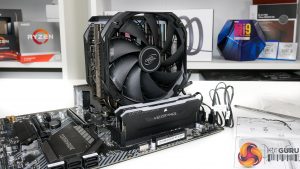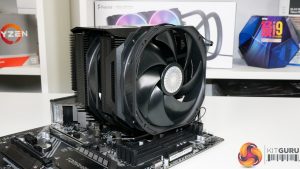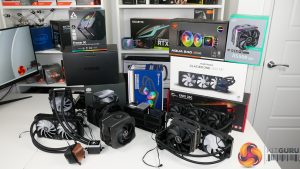Our overclocked test is the main stress test and represents a very tough challenge for these CPU coolers. As we are locking the voltage and clock speed, the temperature figures are directly comparable between competing coolers.
We see package powers in the order of 220W for the CPU and wall power levels that exceed 300W for the system. There is a caveat whereby lesser performing coolers force the CPU to run at higher temperature levels. This, in turn, reduces the operating efficiency and dictates that the CPU draws more power. This increased power draw results in higher operating temperatures, thus further negatively affecting the thermal performance.
This small degree of thermal runaway – albeit very limited in system divergence terms – is important with our manually overclocked 5950X CPU. It perhaps seems unfairly weighted against the lesser performing CPU coolers. But it is the reality of real-world operation whereby higher performing CPU coolers can sometimes show disproportionately better temperature performance at the higher thermal load levels.
Note the use of delta temperature data in our charts and factor in your own ambient conditions for reference.
Given their high-airflow, loud fans, it is not all that surprising to see the AIO liquid coolers performing very well in this high heat load test.
The Asetek-design Phanteks 360mm unit tops our chart with an impressive performance result of around 80C actual load temperature. G.SKILL’s 360mm unit is a few degrees behind, but this is slightly disappointing given its higher noise output at 100% fan speed. The overall performance benefits of Asetek’s premium system design for Phanteks are a factor here.
That point with respect to G.SKILL is especially true when we see Silverstone’s thick 240mm solution practically match its performance level. Silverstone does a good job here, though do note that the installation orientation of the massive CPU block could have an influence depending upon your choice of CPU.
Next in the hierarchy is our first air cooler – the IceGiant ProSiphon Elite – which ties with the 240mm Cougar AIO. That’s a pretty good result for IceGiant given the inherent benefits of air cooling versus liquid (depending on your preference, of course). Though realistically, this low a thermal load is not really doing the IceGiant thermosiphon technology justice versus heatpipe air coolers. The budget Cougar AIO is also doing a stellar job at keeping the high-powered 5950X in the order of mid-80s operating temperatures.
The first result that really surprised us was the DeepCool AS500 Plus. With Noctua NH-D15 matching levels of performance, this single-tower, cost-effective air cooler with preferential noise levels is punching well above its weight. This looks to be an inherent benefit of the single tower cooler design versus the restrictions placed on dual tower coolers.
The way in which single tower coolers are able to have their heatpipes traverse the Ryzen CPU is preferential. This is because of the alignment with respect to the heat-producing core chiplets mounted beneath the heatspreader. Yes, the Ryzen heatspreader and the cooler’s solid base should alleviate this benefit. But the reality is that the ability to dump heat to multiple heatpipes directly through the base and with minimal resistance – as opposed to one or two that traverse the CCX location – is beneficial.
We saw very similar behaviour to this when analysing cooling performance on the nine-chiplet Ryzen Threadripper 3990X CPU, so definitely check out that piece for more details.
Finally, we finish off with the Cooler Master and Arctic dual-tower units. Undeniably, these two disappointed. The MA624 looks to be struggling due to its relatively low speed fans and less preferential heatpipe orientation given its dual-tower design. And the Artic Freezer 50 looks to have hit a point whereby the 5950X’s highly concentrated heat load is a little too much for the dual-tower oriented HDT base to deal with effectively.
The high running temperature of the chip also affected its efficiency under these coolers. That, in turn, forced them to deal with an extra 5-10W of package power compared to some of the other solutions, thus worsening their situation slightly. At 100C real running temperature on both of these coolers, we would certainly recommend reducing the overclock voltage and frequency for safer daily operation.
Thus far, we see trend of the AIO coolers performing well with the 5950X. This comes as little surprise given that AMD themselves has recommending liquid cooling for use with the 16-core beast. Plus, the ability of the copper blocks in the AIOs to deal with the concentrated heat load produced by the Ryzen chip’s localised CCXs is beneficial.
Evidently, though, there is an argument that the AIOs are simply forcing their way to the top of the chart with higher-speed and louder fan solutions. We will have to wait until our 40dBA testing to see how the situation changes.
 KitGuru KitGuru.net – Tech News | Hardware News | Hardware Reviews | IOS | Mobile | Gaming | Graphics Cards
KitGuru KitGuru.net – Tech News | Hardware News | Hardware Reviews | IOS | Mobile | Gaming | Graphics Cards






